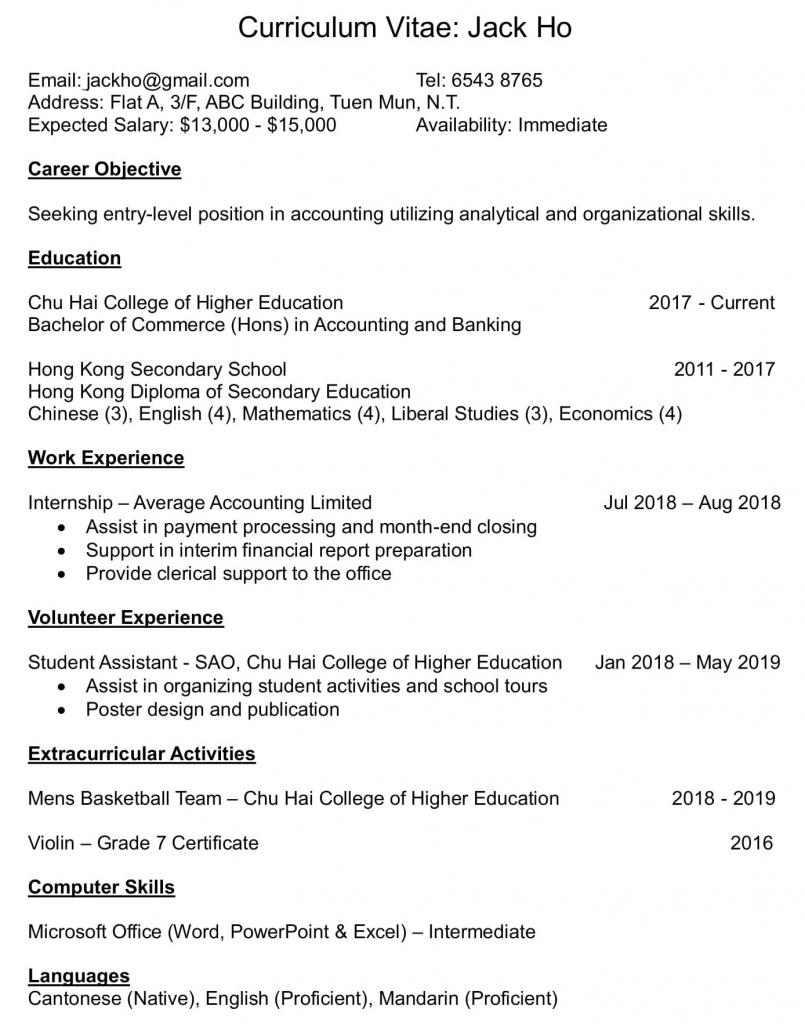A CV is often your first impression to your interviewer. In less than 30 seconds the interviewer has an idea of your education background, your language proficiency, and even some of your characteristics. A good CV will leave a good impression to the interviewer, thus increase your chance to land the position you desired.
Important notes on CV writing
The outlook of your CV is critical. It must be clearly typed, well spaced, and easy to read. Many interviewers only has a glimpse of a CV, because they often receive hundreds of applications per day. For this reason your material should be straight-to-the point, and be clear on your selling points.
A CV does not have to limit to one page, as long as it is concise enough to give the interviewer adequate information about yourself. Also keep in mind that “less is more”, think about the impact of the information you give in the CV, it gives a first impression to the interviewer even before the interview begins.
General recommendations
- Always put your most attractive selling point on top of your CV.
- Well use of headers such as Personal Information, Education Background, Skills, etc.
- Include a session of “Professional Objective” to indicate your career goal
- Put key experience and skills near the top of your CV
- Elaborate measurable skills and accomplishments under work experience
- Use action words to make your CV active
- Education background (name and class of honour of your degree, when and where).
- Keep it tidy and neat (font sizes around 12, and keep it consistent with the font types)
- Keep the resume within 3 pages
- Put the related activities in chronological order
- If you are not graduated, notify the interviewer by adding ‘to current’.
- Some applicants may fill their CV with outstanding graphics to represent their design and computational skills.
A sample CV
This is a sample CV of a third year student. His CV is listed in reverse chronological order, which is a common format used in CV writing.
More CV samples from CTgoodjobs: CV100
Highlights in CV writing for different academic majors
Architecture
- Architecture-related working experience (if any) – which companies you worked for, what projects did you take part in, including part-time, full time, summer job, etc. Jobs not related to Architecture is, in general, irrelevant and should not be included.
- Skills – VERY IMPORTANT- detail your relevant technical, software skills (e.g. AutoCAD, BIM RIVET, Sketch-up, Rhino, Photoshop, AI, In-Design, Microsoft Word, PowerPoint, Excel, I-Movie, etc) and competence level (Excellent/ Good/ Fair/ Basic).
- Design Awards and Scholarships- to show your design competence and ability
- Extra-curricular activities- e.g. positions in Architecture Student Association, being helpers in Architecture Department or other volunteer activities, etc; this shows your leadership, interpersonal skills and characters.
- Design project samples- VERY IMPORTANT- SHOW GOOD PROJECTS ONLY, 4 A4 pages max.- extract of your portfolio to show your design and presentation skills.
Journalism
- Infographics are the way out for advertisement and PR industry. Try to avoid CV with too many words. You are advised to showcase your design concept that can display the personality of yourself.
Engineering
- Students could list out the below software and skill you have learnt during classes such as:
- AutoCAD
- Revit
- Structural robot analysis
- Geographic Information System
- Slope/W
- Plaxis 2D
- SAFE 2016
- SADS
- ETABS
- SAP2000
- If you are the holder of construction industry safety training certificate (such as green card), you could include this too.
- You should also state the professional qualification obtained (g. Member (MHKIE) / Member(MIEAust)) and where they are obtained (e.g. UK or Hong Kong)



